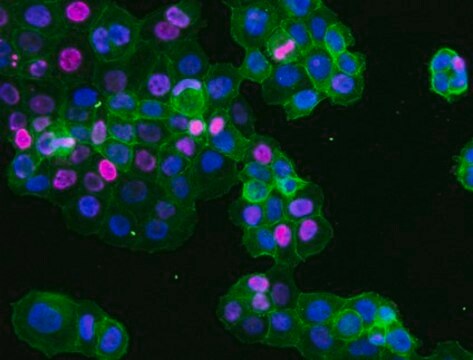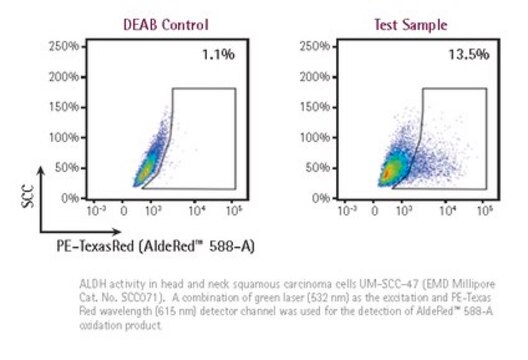MAK321
Acetaldehyde Assay Kit
sufficient for 100 fluorometric tests
Synonym(s):
Acetaldehyde Quantitation Kit
Sign Into View Organizational & Contract Pricing
All Photos(1)
About This Item
UNSPSC Code:
12161503
NACRES:
NA.84
Recommended Products
usage
sufficient for 100 fluorometric tests
input
culture(s)
food(s)
serum
plasma
tissue
urine
beverage(s)
application(s)
cosmetics
food and beverages
detection method
fluorometric
relevant disease(s)
gastrointestinal diseases
storage temp.
−20°C
Related Categories
General description
Acetaldehyde is one of the most widely occurring aldehydes in nature and commonly used in industry. The metabolic byproduct of ethanol in the liver, acetaldehyde is toxic to the human body and rapidly converted to the less harmful acetic acid by the enzyme aldehyde dehydrogenase. People with a deficiency of aldehyde dehydrogenase accumulate acetaldehyde when consuming alcohol and this accumulation results in facial and body flushing known as alcohol flush reaction. Build up of acetaldehyde has also been associated with the effects of hangovers from alcohol consumption. Although classified as a carcinogen, acetaldehyde is naturally found in many foods and beverages such as ripe fruit, coffee, and wine.
Application
The Acetaldehyde Assay Kit may be used for:
- Food and Beverage Testing
- Gastrointestinal Disease Research
Features and Benefits
Enhanced Detection Range: Detect Acetaldehyde levels accurately across a wide range, from 0.5 µM to 60 µM, using only 50 μL of sample in a 96-well plate setup, ensuring comprehensive analysis with minimal sample requirement.
Simplified Process: Experience a streamlined process with the addition of only a single working reagent and a 30 minute room temperature reaction, reducing complexity and saving valuable time and effort.
Compatibility with High-Throughput Systems: Easily incorporate our kit into high-throughput handling systems, ensuring smooth and accurate processing, enhancing efficiency in your laboratory workflow.
Simplified Process: Experience a streamlined process with the addition of only a single working reagent and a 30 minute room temperature reaction, reducing complexity and saving valuable time and effort.
Compatibility with High-Throughput Systems: Easily incorporate our kit into high-throughput handling systems, ensuring smooth and accurate processing, enhancing efficiency in your laboratory workflow.
Suitability
Suitable for biological samples (e.g. plasma, serum, urine, tissue and culture media) and food/beverage samples (e.g. wine, coffee, and juice)
Principle
The fluorimetric acetaldehyde assay is based on aldehyde dehydrogenase catalyzed oxidation of acetaldehyde, in which the generated NADH reduces a probe making it fluorescent. The fluorescence intensity of the product measured at λex/em = 530/585 nm is directly proportional to acetaldehyde concentration in the sample.
Other Notes
For additional information on our range of Biochemicals, please complete this form.
signalword
Danger
hcodes
Hazard Classifications
Eye Dam. 1 - Met. Corr. 1 - Skin Corr. 1B
Storage Class
8A - Combustible corrosive hazardous materials
Certificates of Analysis (COA)
Search for Certificates of Analysis (COA) by entering the products Lot/Batch Number. Lot and Batch Numbers can be found on a product’s label following the words ‘Lot’ or ‘Batch’.
Already Own This Product?
Find documentation for the products that you have recently purchased in the Document Library.
Helmut K Seitz et al.
Genes & nutrition, 5(2), 121-128 (2009-10-23)
Chronic ethanol consumption is a strong risk factor for the development of certain types of cancer including those of the upper aerodigestive tract, the liver, the large intestine and the female breast. Multiple mechanisms are involved in alcohol-mediated carcinogenesis. Among
Mikko Salaspuro
Journal of digestive diseases, 12(2), 51-59 (2011-03-16)
Aldehyde dehydrogenase (ALDH2) and alcohol dehydrogenase (ADH) gene polymorphisms associating with enhanced acetaldehyde exposure and markedly increased cancer risk in alcohol drinkers provide undisputable evidence for acetaldehyde being a local carcinogen not only in esophageal but also in gastric cancer.
Our team of scientists has experience in all areas of research including Life Science, Material Science, Chemical Synthesis, Chromatography, Analytical and many others.
Contact Technical Service




